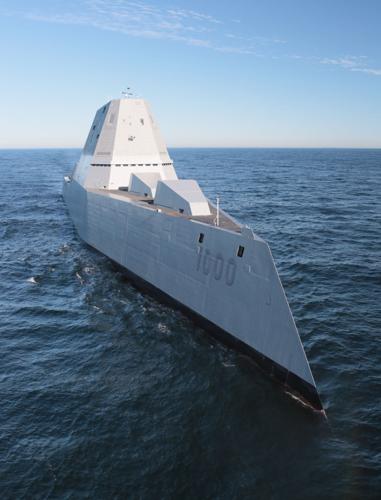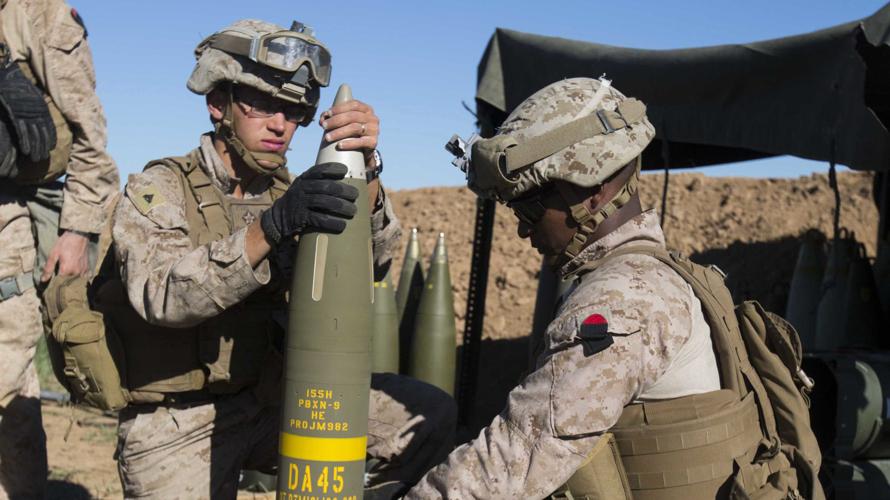U.S. soldiers and Marines have fired Raytheon’s Excalibur guided artillery shell more than 1,000 times in land combat in Iraq and Afghanistan.
Now, Tucson-based Raytheon Missile Systems is vying to take the GPS-guided shell to sea as a precision weapon for naval bombardment.
Co-developed by Raytheon and the Swedish defense contractor Bofors in the late 1990s, the Excalibur M982 was first used in combat by the Army in Iraq in 2007.
Though far more expensive than unguided shells at about $70,000 a copy, the Excalibur has allowed artillery crews to hit targets with an accuracy of a few meters at a distance of 25 to 30 miles, destroying targets with far fewer shells while limiting collateral damage.
Raytheon proposed a version of its land-based Excalibur in response to a 2014 Navy request for information about potential guided shells for the 5-inch diameter guns mounted on the Navy’s destroyers and cruisers.
The company slimmed down its 155 mm, or roughly 6-inch, Excalibur to 5 inches and successfully test-fired the round at the Yuma Proving Ground in September 2015.
The Navy hasn’t formally pursued the 5-inch round further, but a different need for a guided naval projectile has taken priority.
The Navy said in November that Lockheed Martin’s Long Range Land Attack Projectile — a roughly 6-inch, guided round specifically developed as the main land-attack weapon of the new DDG 1000 Zumwalt-class stealth destroyers — had become too expensive to buy.
The reason: Amid massive cost overruns and development delays, the Navy had cut its order for the $4 billion Zumwalt destroyers from an original 32 to just three ships, in turn cutting the need for most of the new naval shells.
Without the ability to scale up production economically, the cost of Lockheed Martin’s Long Range Land Attack Projectile would balloon from an expected $50,000 per round with mass production, to estimates of up to $800,000 apiece to arm just three ships.
Last June, the Navy put out a formal request for information for a potential replacement for the LRLAP, envisioning about two years of development followed by a year of testing.
Paul Daniels, business development lead for Excalibur and other indirect-fire systems at Raytheon Missile Systems, said the Navy must make a decision on a replacement round soon, with the Zumwalt expected to be ready for combat by 2019.
“The Zumwalt itself is to be deployed in a few years, and they need something that’s low-risk, mature, affordable; so the Navy is weighing its options,” Daniels said.
A Navy official said the service is evaluating projectiles from across the industry to find an ammo replacement for the Zumwalt gun.
“To address evolving threats and mission requirements, the Navy is evaluating industry projectile solutions (including conventional and hyper-velocity projectiles) that can also meet the DDG 1000 (Zumwalt) deployment schedule and could potentially be used as an alternative to LRLAP,” Christianne Witten, spokeswoman for the Naval Sea Systems Command, wrote in an email.
At about $70,000, the Excalibur carries a fraction of the cost of Lockheed’s rocket-assisted Long Range Land Attack Projectile, though it has only about half of the LRLAP’s 60-mile minimum range.
“With a combat-proven projectile that’s in production, that has a good chance of working off-the-shelf, so to speak, or with very minor modifications, we think it’s a good choice for the Navy,” Daniels said.
COMPETITION
Raytheon’s last bid to supply the Navy with a 5-inch guided shell didn’t end so well for the company, Navy or taxpayers.
Raytheon developed the Extended Range Guided Munition, a satellite-guided, rocket-assisted projectile, for the Navy in the mid-1990s. But after 14 years of development costing some $600 million, the Pentagon canceled the program in 2008 after several test failures and delays.
While other companies may make a bid to arm the Zumwalt’s gun, any replacement will have to be adapted to the ships’ Automated Gun system, which automatically loads rounds, Daniels said.
Raytheon already has experience adapting Excalibur to artillery guns used by allies such as Sweden, the Netherlands and Australia, and Daniels said the company already has preliminary concepts to adapt the shell to the Zumwalt’s gun.
Raytheon also has tested a version of the Excalibur that uses semi-active laser guidance that follows a laser signal “painted” on a target by a designator on the ground or in the air in its final approach.
Such end-of-flight laser guidance is essential to hit moving targets and would give the Navy the opportunity to expand the weapon’s capabilities, Daniels said, adding that an all-weather radar also could be added.
A defense analyst said the size and technical maturity of Raytheon’s Excalibur may give the company an early leg up in the competition to replace the Zumwalt’s LRLAP.
“The Excalibur round is almost a perfect replacement for that,” said Bryan Clark, senior fellow at the Center for Strategic and Budgetary Assessments in Washington, D.C.
BAE Systems, which acquired Bofors in 2005, could be Raytheon’s biggest competitor to replace the Zumwalt’s gun ammo.
Clark said BAE could offer a 155 mm, or 6-inch, version of its Hyper Velocity Projectile, which was developed for use in a new electronic railgun to be mounted on the Zumwalt-class destroyers.
The railgun program has been delayed and is now planned for deployment several years away on the third ship of the class.
But Navy officials have said they are exploring the use of BAE’s radar-guided Hyper Velocity Projectile — which carries no explosive but destroys its targets with supersonic impact — in regular naval “powder” guns.
Clark said the BAE’s round could work, but it may be too early in development to satisfy the Navy’s need for a quick Zumwalt replacement.
“I think it will all come down to technical maturity,” he said.
Though the quest for a guided 5-inch naval shell seems less of a priority now, Raytheon may get some competition from BAE on that program, too.
BAE also has successfully tested the Multi-Service Standard Guided Projectile (MS-SGP), a 5-inch guided projectile designed to be used in land artillery or naval guns.
The shell has a range of about 60 miles and can be upgraded with laser guidance to hit moving targets, BAE says.





